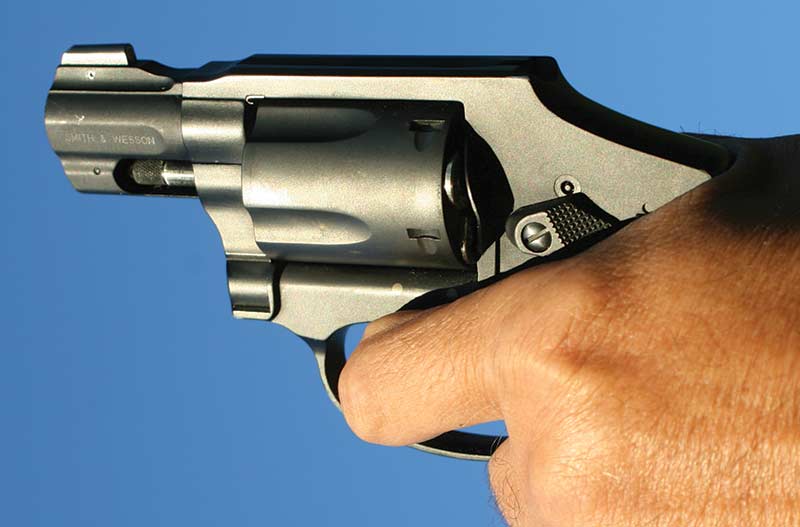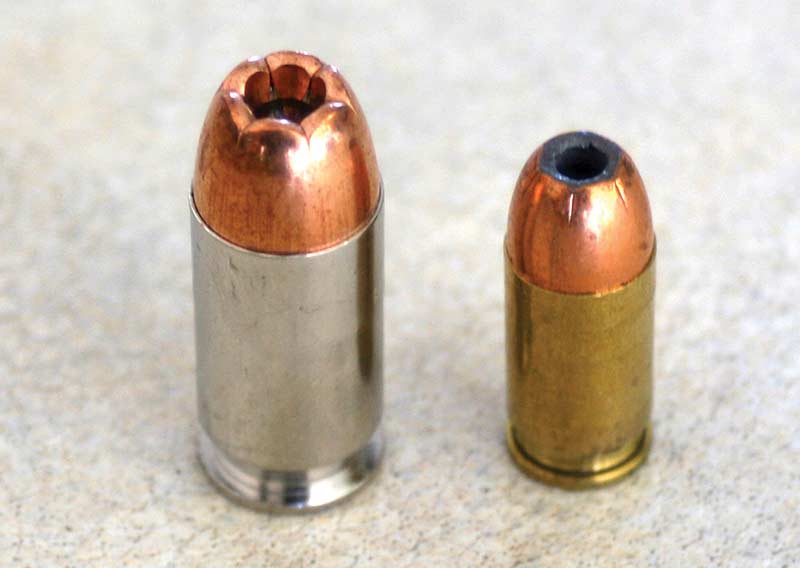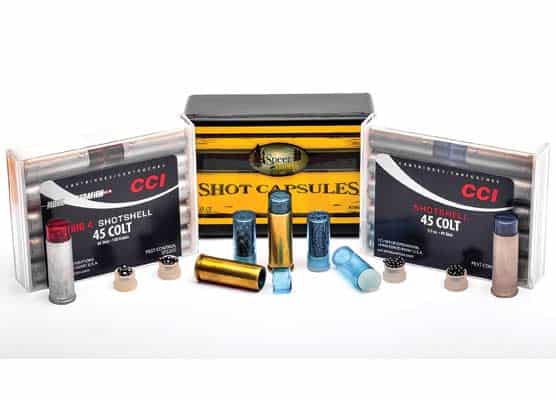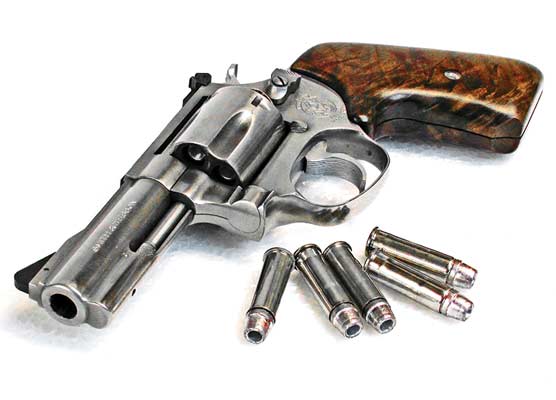Lessons Learned Through A Lifetime Of Study
Once you get into the world of defensive
use of force, you discover things aren’t
the way they looked from the outside
For most of America’s history, gunfighting was taught strictly by and to police and military, and knowledge of deadly force law was just as tightly restricted to law schools and police academies. That left armed citizens only one course: to become selftaught, like kids in a schoolyard trying to figure out sex in the absence of structured sex education or parental explanation. In either case, the result can be pain and tragedy that come from preventable ignorance.
In the mid-1970s, that changed. Jeff Cooper founded the American Pistol Institute at Gunsite, Ray Chapman and a handful of friends and investors created the Chapman Academy; and John Farnam developed the traveling school that became Defense Training International. Time has taken Jeff and Ray away from us, though Farnam still teaches nationwide, as a host of others do today. Including me: I founded the Lethal Force Institute in 1981, creating a curriculum focused more to the “when” than the “how” of it, and shave spent more of my time doing that than anything else to this day. It has been estimated there are thousands of people now teaching this stuff to private citizens, mostly part-time. There will be more when the current generation of combat troops returns to civilian life after their service in “the sandbox.”
From Scratch
I wish such publicly accessible training had existed when I was starting to learn. We were stuck with books, and the anecdotal knowledge we could garner from debriefing whatever gunfight survivors we could, and from talking to cops and lawyers and judges who’d been through all the aftermath elements of self-defense shootings. Each of us had to separately re-invent the wheel to find out what we needed to know. Today’s situation is far, far better for the responsible armed citizen.
As time went on, I became a parttime officer responsible for training the entire police department in weapons and deadly force, a definite “brain cells front and center!” kind of moment. This early experience led me on an odyssey to seek out the best such training in the US and even abroad. Having also become a writer for gun magazines and police journals helped it gave me entry into the law enforcement agencies who had done the best work and the deepest study in terms of learning from past tragedies and keeping their members alive in gunfights.
I was fortunate to be allowed to go on stakeout with the NYPD Stakeout Squad, ride unarmed (thank God for hosting officers with backup guns!) on NYPD, and armed with my own guns on LAPD, each time in the heaviest-action precincts or districts. The situation allowed me to take the then-most-advanced officer survival training that the Federal Law Enforcement Training Center had to offer, and more like it elsewhere.
By 1979, I had been tapped as an expert witness in court cases both criminal and civil, involving weapons and deadly force. That was an eyeopener: the discovery that the legal system we had all been promised in Civics 101 was sometimes more about drama than law. And accusing prosecutors or plaintiffs’ lawyers could make up the most outrageous BS and have it dignified in the courtroom as “their theory of the case,” to be weighed by the jury as if it had the same credibility as the truth. Almost 30 years as an expert witness, well over that as an instructor, and now 35 years of carrying a badge and more years of carrying a gun have combined to help me learn a few things that weren’t obvious when I started.
It Won’t Be Pretty
An entertainment media that glorifies violence has implied to generations of Americans they’ll shoot down the bad guys at high noon on Main Street and walk off into the sunset, triumphant. The reality is it doesn’t always work that way.
Very early on, it became apparent to me people who’d had to kill in even the most righteous self-defense suffered for it. People look at you differently. Dr. Walter Gorski, the brilliant police psychologist who was probably the first to identify “post shooting trauma” as a separate and distinct subset of post traumatic stress disorder (PTSD), trained me circa 1980. Dr. Gorski coined the term Mark of Cain to explain the syndrome where people don’t always treat you as the good cop, the good parent, or the good neighbor after you’ve killed another human being — they treat you as He Who Kills. It changes the way people see you, and it changes the way you see yourself.
You’ll find your spouse listening to muttered comments in the market or the restaurant about you having “killed someone and gotten away with it.” Your kids may come home from school crying after another child torments them with, “my daddy says your daddy’s a murderer!”
A good friend of mine who has been forced to kill more than once, and never even had to go to court over the slayings, refers to this as “the cost of it.” That cost runs deep and lasts your life long.
If you are not prepared for some of these sociological manifestations in the aftermath, they can tear you and your family apart. Divorce rates and other family estrangements run high after you’ve been forced to shoot in self-defense. “… in sickness and in health” does not include “oh, yeah, and when your spouse is demonized as a murderer by lawyers and newspapers, you’re supposed to stick by him or her then, too.”
And then, of course, there is the courtroom aftermath …
Day In Court
Early in my career as an expert witness, I was called in for a case where a young officer had shot and killed an even younger criminal who had tried to pull a gun on him and his rookie partner while they were trying to arrest him for illegal possession of a firearm. It was a classic case of justifiable homicide in the line of duty. However, the shooting was cross racial. It triggered a violent race riot; and the city needed a scapegoat. The chief prosecutor of the jurisdiction — Janet Reno, who would later become US Attorney General under President Bill Clinton — charged him with manslaughter on the utterly trumped up theory that he had recklessly and negligently cocked the hammer of his department issue service revolver, and accidentally discharged it in panic when the man turned with his hands raised in surrender.
Fortunately, Officer Luis Alvarez had two of the finest defense attorneys in America, Roy Black and Mark Seiden. After eight weeks of meticulously dismantling the state’s BS case in court, they won an acquittal. (Which triggered another race riot, but that’s another story.) You can read about it from the horse’s mouth in Roy Black’s autobiographical book, “Black’s Law.”
An anomaly? Hardly. I take mostly defense cases, for the simple reason the prosecution already has more ready and less expensive access to people in the same field as mine at their local police academies. I’ve discovered over the years when a prosecutor hires an outside expert instead, it’s usually because to make their case they need things to be said that no honest police instructor will say. There are exceptions — for instance, when they think the jury will perceive local cops testifying against a cop-killer as having an ax to grind — but those are uncommon.
I turn down more cases than I take. I won’t sign onto a case unless I believe the defendant is on the side of the angels, after reviewing all available discovery materials (investigative reports, witness statements, sworn depositions, etc.). Yet, at any given time, I’m juggling about 10 of them in progress, and I’m just one of many who work in the same field. That adds up to a helluva lot of wrongful prosecutions, and more unmeritorious lawsuits. (Quick translation: “unmeritorious” is the legal term for “BS.”)
How Many?
That tells you there are a helluva lot of unjustly accused cops and armed citizens out there. FACT: There are more attorneys in the United States than police officers. FACT: Anybody pretty much can sue anybody for damn near anything. The quagmire of courtroom procedure requires countless hours of time from the attorney, which you have to pay for at a rate of three figures per hour. ($500 per hour is not an uncommon fee among the best attorneys.) Yeah, you can try to sue the estate of the violent criminal who forced you to shoot him, but that will be an expensive exercise in futility, because his “estate” probably doesn’t add up to much more than a crack pipe and a cheap knife, and both of those are in evidence as property of the Court.
Most prosecutors I’ve dealt with over the decades are decent, honest men and women who understand their job is to find justice, not to mindlessly pursue convictions. Unfortunately, some of them are political creatures who are perfectly willing to destroy your life to pander to public opinion and gather votes for the next election. And they are outnumbered by plaintiffs’ lawyers who are far more concerned with money than with justice, and are totally prepared to smear you publicly and destroy your life with a false allegation if it might mean a big courtroom payday. One such attorney once told newspaper reporters he considered the jury to be the tapestry upon which he would weave his alternate reality of the case. When put forth by a practicing attorney – an officer of the Court – that “alternate reality” is taken seriously, and you will have to fight it seriously… and expensively. I have seen people lose their homes, lose their businesses, and go bankrupt in the course of fighting to prove their innocence. Hollow victories aren’t really victories.
Wishful Thinking
The Sarah Bradys of the world will tell you, “You don’t need a gun for self-defense. All that matters is that you not go looking for trouble.” You already know how false that is. Yet, amazingly, responsible people who’ve seen the logic of being armed and carry guns themselves will sometimes tell you, “you don’t need to worry about the aftermath of a defensive shooting. All that matters is it be a clean shoot.” Same game, same denial syndrome, just one level up.
In Arizona, a hiker shot a violent man who attacked him at a trailhead. The lead investigator determined it to be self-defense, and so did the prosecutor’s office, until influential, voting friends of the deceased presented a petition to the prosecutor to bring the shooter to trial. The prosecutor obediently did and convicted the armed citizen of second-degree murder. The defendant is in prison as I write this. In Texas, a young cop shot and killed a man who was lunging at a brother officer with a knife. An obvious “clean shoot” until Johnny Cochran labeled it racist police brutality, and led marches in the city’s streets until charges of murder were filed. We won an acquittal on that one.
There are also those who say, “Those legal aftermath horror stories may happen in California or New York or New Jersey, but I live in gunfriendly Texas (or Arizona), so I’m safe from that.” Please re-read the paragraph above.
If you’ll forgive a little triteness, “denial” is not a river in Egypt, and hope is not a strategy. Be aware that
unmeritorious litigation may follow the most righteous self-defense shooting, criminal or civil or both, and be prepared for it. The wary hawk and eagle are far more effective warrior birds than the ostrich with its head in the sand.
Hardware
Over the decades I learned that a lot of the old, conventional wisdom was absolutely correct. For instance, “use the most powerful gun you can control,” and Robert Ruark’s famous book title exhortation, “Use Enough Gun.” I saw case after case where .380s and less-than-optimal 9mm loadings left the guy on the other side of the gun up and running until he had been riddled with too many bullets to possibly survive, and the public got the impression the dead man was a victim of malicious overkill. Trials usually resulted if the shooter survived the murderous assault of the attacker who had to be shot that many times before he went down. In one case I did, the cop had to pump 17 rounds of 9mm into a suicidal/homicidal attacker before the man fell, literally at his feet, still holding the heavy metal pipe he’d attempted to bash three officers’ brains out with. Once finally cleared of wrongdoing, that officer finished his career carrying a 14-shot, .45 caliber Glock 21 on duty.
I learned rounds which did great in testing protocols — the original 115 grain 9mm Silvertip in the Roma Plastilena clay of the time, the original 147 grain subsonic 9mm JHP in Fackler-formula gelatin — were mediocre man-stoppers at best in actual street gunfights. Winchester tweaked the Silvertip to where it worked better, and today all the makers have improved the subsonic 147 to where it will reliably open (with high tech bullet designs), but collective gunfighting history left me more comfortable with 124 and 127 and even 115 grain bullets that went much faster and damaged more tissue. Most of the police departments that adopted the early 147 grain 9mm loads either went to something hotter in the caliber, or — more often — approved or adopted more powerful pistols in .40 S&W, .357 SIG, or .45. As Santayana said, “those who do not learn from history are doomed to repeat it.”
I learned that all the “stopping power theories” – Momentum Theory, Temporary Wound Cavity Theory, Penetration Theory — had something to them, but none was the whole solution to a very complicated puzzle that we’ll probably never solve. I learned that each theory had some validity at its core, but no one factor was the “everything” its proponents said it was. Everything is something; nothing is everything.
Hits Count
I learned that only hits count. The men and women who took an instant to get their front sight on target made their hits. The Anchorage Police Department and the LAPD Special Investigations Section emphasized Jeff Cooper’s concept of the flash
sight picture in training, and were rewarded with hits in the 90% range in actual gunfights. Bill Allard of the NYPD Stakeout Squad, who killed more armed criminals in gunfights than even his more famous partner Jim Cirillo, used a hard marksman’s sight picture for every shot he fired in action but one, and never missed the man he was shooting at. This was not a 20th Century discovery. In his 19th Century gunfights, Wyatt Earp later told his biographer Stuart Lake, he always raised his weapon to eye level, aligned the sights, and took care to squeeze rather than jerk his trigger.
I learned to tailor the tool to the task. In the 1970s, I was allowed to study the experience of the Illinois State Police, then the only large department issuing a semiautomatic service pistol, the S&W Model 39 9mm. I was able to identify thirteen troopers who had survived incidents in which they probably would have died had they been using revolvers. Two were firepower situations, where the armed attacker went down to the seventh or eighth pistol shot and there would not have been time to reload after six. Two more survived in a single incident against a murderous two-gun outlaw biker, where sustained fire including fast reloading won the day, and it took more than a dozen gunshot wounds to end the fight. The other nine survived when the bad guys got their guns away from them, tried to shoot them with their own weapons, and couldn’t. A few of those arose from the troopers pressing their magazine release buttons, dropping the magazine and activating the S&W disconnector so the chambered round could not be fired, as they felt the assailant winning the struggle. The rest were cases where the trooper carried on-safe, and the would-be cop-killer who gained control of his weapon couldn’t find “the switch that turned on the gun” in time to carry out his murderous intentions.
Throughout the nation, I found other cases of the same pattern. I also found case after case where a second weapon saved the officer’s life in such situations, and where a backup gun might have saved a murdered cop’s life, if he’d only had one. I even found some armed citizens whose lives had been saved by a second weapon. I learned to carry two guns.
I also saw cases where a good guy had to ram an auto pistol against a homicidal attacker’s body and pull the trigger and nothing happened. The auto’s slide had been pushed out of battery and it couldn’t fire. I learned to carry an auto and a revolver. If it turns out that St. Peter preferred Jeff Cooper or Bill Jordan, I figured I was covered.
Ammo Issues
Anti-gun types have attacked our ammo as well as our firearms since long before I came on the scene. It happens in the press, it happens in State Houses, and yes, it also happens in the courts. “Ladies and gentlemen of the jury, he established malice when he loaded his gun with hollow-nose dum-dum bullets, designed to rend and tear brutal wounds and cause horrible pain and suffering and ensure the agonizing death of his victim!” It happens more routinely than you’d think in armed citizen shooting trials, though rarely in police shooting cases since hollow points became the law enforcement standard.
This argument is, no pun intended, easy to shoot down … if your lawyer knows how. We simply establish that you chose the same type of ammo as the police, for the same reasons. With hollow points, the bullets are less likely to over-penetrate the body of the dangerous felon and strike down unseen innocent bystanders, and also less likely to ricochet and create unintended additional victims. Moreover, since history shows us the improved stopping effect of the HP ammo means the bad guy will have to be shot fewer times to neutralize his violent activity, he is relatively less likely to die of his wounds. However, the argument in favor of hollow point ammo is useless if not effectively presented by the defense. Famed appellate lawyer Lisa Steele has seen defendants convicted with this argument when their trial lawyers failed to neutralize the poison. So have I. This apparently happened in the Arizona case mentioned above, contributing to what I for one believe was a wrongful conviction.
Handloads?
While it’s a slam-dunk to defend your use of hollow point ammo, the use of handloads in a shooting presents much more serious problems to your defense team. Defensive shootings are often very close-range affairs in which gunshot residue (GSR) from your muzzle is deposited on your attacker’s body or clothing. This can become a critical evidentiary factor if the other side insists he was too far away from you to endanger you at the moment he was shot. The distance testing is done with exemplar ammunition, that is, ammo identical to what was in your gun, but not the same exact cartridges. Don’t count on the crime lab testing the remaining rounds from your weapon as taken into evidence at the shooting scene. If the fight was sufficiently intense, there may not be any rounds left in the gun that saved your life. Even if there are remaining cartridges in evidence, they may not be tested. The prosecutor can argue, “Your honor, firing those cartridges consumes them! It’s destructive testing! The defense is asking the Court’s permission to destroy the evidence! You cannot allow it!” Do you think that’s a BS argument? So did I … until I saw a judge accept it, in a case where handloads were used in the death weapon, but the state crime lab tested with a much more powerful factory load, based on the headstamp on the reloaded casings. That gave a false indication of distance involved, and the defendant — whom I have strong reason to believe was innocent — was convicted of manslaughter.
You’d think the court would take the reloader’s records into account and allow testing based on that. It doesn’t happen. No one has yet been able to offer a case where the Court took the reloader’s data or word for what was in the load. It’s seen as self-serving “evidence” that can’t be independently verified. Sort of like a rape suspect saying, “I couldn’t
have done it, because it says right here in my own diary that I was somewhere else that day.”
After seeing these things in court, I learned to avoid the use of handloads for defensive purposes.
Final Thoughts
I’ve run out of space to share here. Fortunately, you haven’t run out of time to learn the realities of using lethal force in defense of self and others. Let me leave you with one final thought.
Remember these things don’t always end with the person who used lawful defensive force being put through legal and social hell in the aftermath. Most of the time, the system works and justice is done. Just as most of the time, we are not violently attacked with a level of force that warrants defensive gunfire. The fights we prepare for, on the street to start and in court later, are relatively rare occurrences. However, the degree of loss we face if we aren’t ready to win those fights is so great that it warrants our preparation for them beforehand. It’s true for the street, and just as true for court.
Most people who’ve had to do it will tell you that being forced to kill a person in self-defense in this society sucks. But, they’ll also tell you it beats hell out of being dead. It’s sort of like taking radiation or chemotherapy after being diagnosed with cancer. The side effects will cause you to suffer, but it’s better by far than dying of the disease.
In either case, there is a responsibility for those involved in the treatment protocol to warn the patients and prospective patients of those potential side effects. And that, I suspect, is the reason the editor asked me to write this article.
Good luck. Stay safe.
Subscribe To American Handgunner

Get More Personal Defense Tips!
Sign up for the Personal Defense newsletter here:













